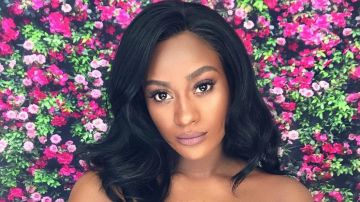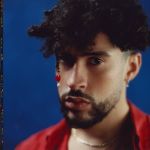This YouTuber Is Boldly Fighting Against Colorism in the Latinx Community
It takes a special type of woman to confront adversity with intention

Photo: Courtesy of Monica Veloz
It takes a special type of woman to confront adversity with intention. Monica Veloz aka @monicastylemuse is one of those women. As a proud first generation Dominicana from Brooklyn, Veloz entered the Latina beauty vlogging world knowing full well that it would be uncomfortable and often times disheartening. The national conversation about shade representation in beauty products rocked the internet this summer as Rihanna dropped Fenty Beauty on us. To fairer-skinned women and girls, excitement swirled around the amazing hyper-pigmented highlighters and contour packs. But to women and girls with darker skin complexions it brought up a completely different kind of excitement; for many it was the first time foundation was made in their shade. Veloz is quite familiar with that struggle, in fact she routinely tests low cost dark foundations for her fans since darker shades can be toxic, hard to find, and generally cost more. It’s all a part of her mission to take up space and use her YouTube channel as an outlet for those who feel ignored and overlooked by the limited view of what it means to be Latino.
As Veloz puts it, “There is just so much to be explored within the Latino community. [Afro-Latinidad] unfortunately still feels so foreign! Like come on. When did any Latino become too much or too little of something, when we’re everything!”
Veloz started out in the fashion industry with her brother Juan who is a photographer. He’d shoot, she’d style, and that’s where she found her love of stepping out from behind the scenes. She became her brothers on camera “style muse” and eventually it led her to YouTube. “I thought that with YouTube I could share my talents with the world instead of just one person.” She told HipLatina “I was inspired. One of my friends told me about a stylist competition that was on YouTube. I said ‘Oh I’ll do it,’ it was my first video. It’s still there. I shot it with an iphone 5 and I keep it there so that people can see that you’ve got to start somewhere.” Veloz got such positive feedback from viewers that she continued to make videos that chronicle not only her style and makeup skills but her family. “I’m literally an open book. And I’m okay with who I am as a person. I’m okay with showing my flaws.”
Her vulnerability and openness could explain why her fans, or as she affectionately calls them, her “muses,” are so fiercely loyal. Her videos include pranks on her family, reading mean comments, teaching viewers Dominican slang and teaching her boyfriend Spanish. But Veloz admits that she didn’t feel any particular backlash for having dark skin until she started using #Latina in her videos. “People in the comments were telling me I had to pick one. I’m a Black girl who speaks Spanish, it shouldn’t be that difficult to understand,” she laughs.
Veloz’s experience is one shared by millions of Afro-Latinos worldwide and is something the Latino community continues to grapple with in the U.S. as well as in their countries of origin. Historically, Black women have always struggled to find their place in the beauty industry simply because the beauty standard has always praised and imposed whiteness – thin noses, straight hair, thin bodies, and light skin color. Today we’ve seen the rise of Fit Thick, full lips, curly hair and larger posteriors that mirror and exaggerate Black and brown bodies. But even those features are considered more desirable on white women (i.e. Kylie Jenner) but that’s an article for another day. More often than not mainstream conversations about Black beauty have revolved around increasing their proximity to whiteness by way of altering, rather than enhancing their features or by ignoring them altogether. Skin lightening is still an unfortunate “trend” (ahem, Sammy Sosa) and the conversation about the political nature of the natural hair movement could go on forever.
For Afro-Latinas this reality is compounded. Women like Veloz don’t fit neatly into the “African American” category or into media accepted versions of fair skinned Latinidad. Needless to say, Afro-Latinos attempt to carve out a space for themselves within the collective consciousness has been fraught with negativity and pushback from both Latinos and African Americans. “My grandmothers grew up during Trujillo’s time and we were not what he wanted. He wanted blond haired, blue eyed people. We can’t deny that we’re Black. So when people tell me that I can’t be Black and Afro-Latina, they are basically erasing me being a Black woman. We all have different struggles. We were all put on a ship and dropped off at different places. I don’t understand why it pisses people off that I’m so proud of my family’s culture. I’m going to keep doing what I do because at the end of the day being Black and being Latina is so powerful.”
Recently Ilia Calderón made history for being the first Afro-Latina co-anchor on Noticiero Univision. And slowly but surely more Afro-Latino faces have been popping up in novelas and – most notably – in music due to the rise of reggaeton, which was ignored for decades for being “ghetto” or for “black people.” Veloz recalls watching Luz Clarita on Univision and being unable to understand why those stories didn’t include people who looked like her. “I was talking to my family on how there is such a lack of diversity [on TV]. Why don’t we see people who look like us on these telenovelas? This is all we watch! If you’re a Latina you know la novela – eso el ultimo!”
In a recent Attn: video Veloz addressed the consequences the lack of Afro-Latino representation has on the younger generation. As she tells HipLatina the response was predominantly negative, ‘basically people were asking: ‘why do you need to be represented in the television when you watch a show?’ And I think it’s really disgusting that people don’t think that’s important. Where I’m at in my life I don’t really need to see a dark-skinned Latinas for me to feel validated, but when I was younger that meant so much to me. You know when you don’t see someone who looks like your mom, or who looks like you, you kind of lose hope. Seeing yourself as a doctor or seeing yourself as the President of the United States – you should be able to think those things are possible.”
Today Veloz simply twirls on her haters. This year she made the jump to full-time YouTuber and has landed brand partnerships with brands like Target, Sephora, Rimmel London, Nylon, Ponds and most notably L’Oreal, which sent her to the Latin Grammy’s. As she climbs to the heights of YouTube stardom, it will be exciting to see what she does next in her goal to normalize and make Afro-Latinidad more visible. “I’m ready to keep making people uncomfortable, that’s like my goal in life.”
For more about @monicastylemuse you can subscribe to her youtube channel here and her Instagram here.
[article_ad]















